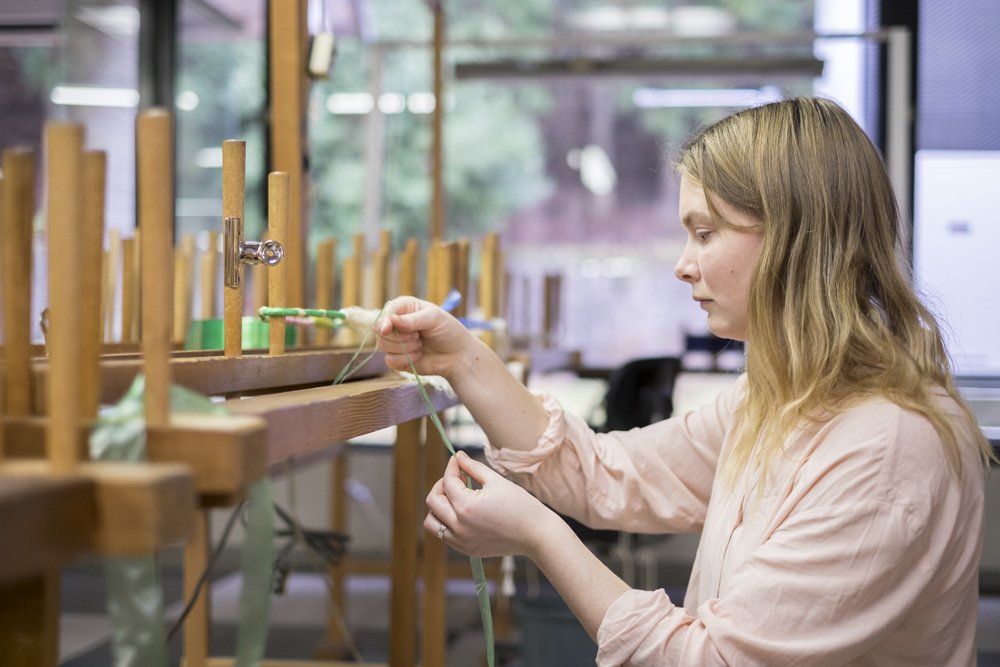My name is Maria Sandberg and I am a Master of Fine Arts student specializing in Textile Design at HDK in Gothenburg, Sweden. During almost five weeks I am studying here to learn japanese weaving techniques and to use materials like bamboo and hemp since my work back in Sweden also is about studying how to work with textiles in a sustainable way from the very beginning with the growing of the fibre.
I came to Kawashima Textile School directly from crowded Tokyo, and at once I felt relaxed and focused having the beautiful mountains surrounding the school. The first week I was the only international student staying here and it was really nice to get to know the other Japanese weave students and the helpful teachers and not to forget being served fantastic food in the cafeteria three times a day!
I started with a basic Kasuri course followed by a basic Nassen course together with Janne, a Finnish textile student. I had never been painting on the warp before and the result with the weft being shown in the paintings were amazing to me. I wanted to do more! I decided to choose the Nassen technique in my coming Applied Kasuri course and at the same time I found two really soft Japanese bamboo yarns as material for the weft. I experimented with a thin ramie warp in my first Nassen weave because I couldn’t find a thin enough flax at that time. It was an interesting experience handling a very fine weave, and also to learn how the ramie behaved as a warp. The result was a very soft and thin fabric but the Nassen technique didn’t quite show because of the very fine bamboo yarn. So, I wanted to continue to experiment with my thick bamboo yarn and decided to test with a thick flax yarn as a warp. I had never treated my warp with starch before so that was a learning experience for me. Also, I had to take out half of my warp yarns to be able to weave! The flaxwarp was very difficult to handle! I wasn’t 100 % satisfied with the result, but I was very satisfied with the process and what I learned. I experiemented with both "es colour (resinous pigments)" and direct dyes and that was also completely different. I liked the watercolour effect I got with direct dyes, and also it sunk into the fibre much easier than the es colour. However, it is much easy to mix colour and get the exact colour you want with es colour. I spent many hours trying to get the right colours in the dyelab as for the directdye. But since I love mixing colours that was only enjoyable to me! I will definately use both in future weaves.
What I liked most from the result from my thicker bamboo/flax fabric are the bamboo yarns lustre in contrast to the warp painting. I will continue in Sweden with a more dense cotton warp and use the same thick bamboo yarn again in a different pattern. Then I think I will also be 100 % satisfied with my result! My stay here definately got me hooked on nassen.
Both weaving techniques were new to me and I have already bought equipment for continuing with Kasuri and Nassen back in Sweden!
I didn’t do any clothes shopping in Japan, but instead I was yarn shopping a lot! Kyoto has very nice yarn stores, and on the last day before leaving I also got really nice hempyarn from my South Korean classmate Boyeun! And Morinaga’s caramel that I enjoyed a lot too...
The one-day-course in natural dyeing was also something I really enjoyed, just to be able to pick the leaves myself in the school’s garden with trees planted especially for the natural dyeing!
During weekends I have been shown around Kyoto by my classmates to both vintage and antique kimono shops to learn more about periods and techniques, as well as nice textile galleries, textile performances and yarn stores. I was also lucky to get the opportunity to see both traditional clothes at the Jidai Festival and the amazing Kurama Fire Festival, just 25 minutes walking up the mountains from the school.
I am also very happy I got to experience the school’s own festival, Momiji Festival, with participating in tea ceremony, seeing all the students in their stunning kimonos and learning how to dress properly in the kimono I have bought here. I bought both kimono, obi, obiage, obijime, nagajuban, geta shoes, tabi socks and haori here in the many vintage kimono shops all around Kyoto!
To me, India and Japan are the most interesting countries for textiles and weaving. I have already experienced living in India and learning some techniques there and now my dream to do the same in Japan also came true - and Kawashima Textile School turned out to be the really good place to do that!






